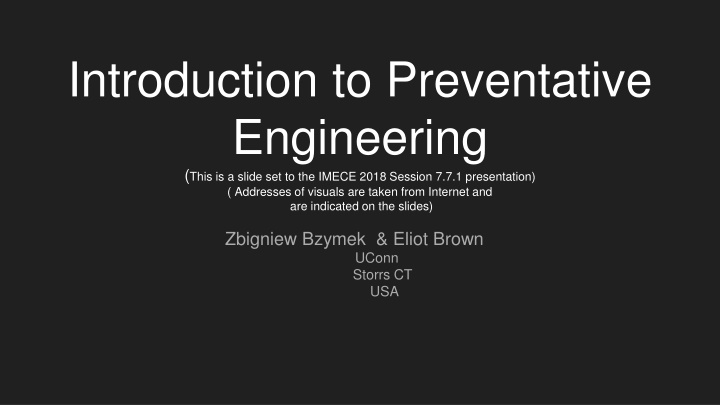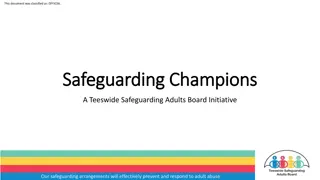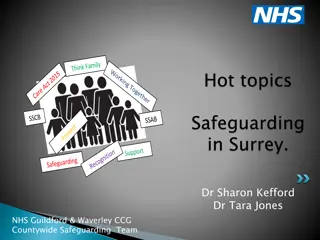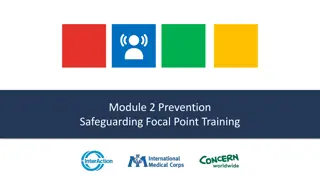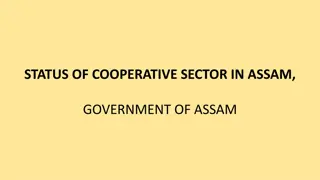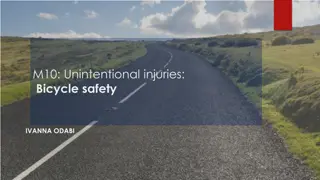Emerging Field of Preventative Engineering: Safeguarding Societies Against Modern Challenges
Preventative engineering emerges as a vital field focusing on mitigating potential harms, disasters, and threats to human lives and economies. By studying, designing, and creating innovative solutions, engineers play a crucial role in transforming harmful situations into positive outcomes, emphasizing the protection of societies and individuals. This shift towards preventative engineering seeks to address the ever-evolving challenges faced by humanity, driving positive changes and ensuring human growth and development.
Uploaded on Sep 16, 2024 | 2 Views
Download Presentation

Please find below an Image/Link to download the presentation.
The content on the website is provided AS IS for your information and personal use only. It may not be sold, licensed, or shared on other websites without obtaining consent from the author.If you encounter any issues during the download, it is possible that the publisher has removed the file from their server.
You are allowed to download the files provided on this website for personal or commercial use, subject to the condition that they are used lawfully. All files are the property of their respective owners.
The content on the website is provided AS IS for your information and personal use only. It may not be sold, licensed, or shared on other websites without obtaining consent from the author.
E N D
Presentation Transcript
Introduction to Preventative Engineering (This is a slide set to the IMECE 2018 Session 7.7.1 presentation) ( Addresses of visuals are taken from Internet and are indicated on the slides) Zbigniew Bzymek & Eliot Brown UConn Storrs CT USA
'Nothing endures but change.' 'Character is destiny Heraclitus . /stories/2018/08/coastal- county-population-rises.html Preamble https://www.census.gov/library The World is developing and changing Heraklit from Efez Panta rhei ( Everything Flows ) Nature, societies, economy, technology - everything changes For the Bust of Heraclitus go to: https:/https://www.pinteres t.com/pin/4000463793839 73755/ / Visited: April 2019 The changes very often bring dangers The dangers are created by Nature and Humans (Intentionally and Unintentionally) Engineering as a profession has obligation to protect societies from those dangers (a privilege of engineers is to make positive revolution )
What Is Preventative Engineering Engineering Technology Innovation Study, Design, and Construction BTIPS Module - Prediction: Changes from Harmful into Neutral, from Neutral into Positive Protecting societies & individuals Creating structures, equipment, regulations Regulatory Policy - human friendly
Thesis Preventative Engineering will be a new complex aspect of engineering. This engineering will focus on modern prevalent problems that continue to cause harm to lives, economies, and prevent human growth.
Branches of Engineering C Civil Engineering Science & Engineering C Computer C Chemical Engineering C Information Technology C Prevention/ Preventative Engineering Engineering Branch: C Electrical Engineering C Electronics Engineering Mechanical Engineering A new branch of engineering called Prevention/Preventative Engineering is proposed. Prevention/Preventative Engineering contains the innovation and design tools that look into minimizing/eliminating the disasters & harms that mankind directly faces and endures.
Influence of nature: Air: Hurricanes, cyclones, typhoons, tornados and combinations of those; Water: tropical rains, hail, rivers flood, high ocean waves, floods and combinations of those; Electricity: storm electricity, straight lighting, ball lighting, fire; Earth: earthquake, tsunami, volcano,mad slides, earth pit holes.
Influence of Nature Influence of Earth: of earth Nuclear Explosion (Human action) Clones Drought Iron Fall On Chemical contamination Eruption Earthquake Lava Flood Ash Fall Hurricane Smelling lake (Surroun dings of) Earth (Surroun dings of) Earth Earth (History of) Earth Earth Tornado Smelling crack Earth (Surface) Earth (Surface) Earth (Surface) Cyclone Tsunami Avalanche holes Land slide Wildfire Earth pit holes
Hurricanes Date and Time when Happened, Period of Lasting Kind of storm and name, wind speed, lowest pressure Areas affected Damages done, costs of damages, fatalities Structures damaged September 6 21, 1900 The Great Galveston Hurricane of 1900 Puerto Rico, Lesser Antilles, Jamaica, Cuba, Turks & Caicos, Florida, Mississippi, Bahamas, Louisiana Texas, Oklahoma, Kansas, Nebraska, Iowa Deadliest natural disaster in US history, Fatalities: 6,000-12,000 Damage: $21 million ($618 million value in 2017) Dwelling houses, public buildings, religious buildings, roads, bridges Highest Winds: 145 mph Lowest Pressure: 936 mbar; 27.64 inHG August 14 - 22 1969 Camille, 1969 Wind Speed: 175 mph Lowest Pressure: 900 mbar; 26.58 inHg Cuba, Yucatan Peninsula, Alabama, Mississippi, Louisiana Second most intense hurricane to strike the US. Damage: $1.4 billion 1969 USD ($3.19 billion 2018 USD) Fatalities: 259 Whole towns September 13-28, 2004 Hurricane Jeanne Highest winds: 120 mph (195 km/h) Lowest pressure: 950 mbar (950 hPa, 28.5 inHg U.S. Virgin Islands, Puerto Rico, Dominican Republic, Haiti, Bahamas Florida, also flooding and damages in other easterns US states Damage: $7.94 billion 2004 USD ($10.61 billion 2018 USD) Fatalities: 3,037 Most deaths in Haiti, about 3,006 US had the most damage done of about $7.5 billion. One of the most deadly hurricanes ever. Gonaives the town in Haiti was almost washed away by floods and mudslides. September 16 2017 October 2, 2017 Hurricane Maria, Highest winds: 175 mph (280 km/h) Lowest Pressure: 908 mbar; 26.81inHg Puerto Rico, Dominican English, Virgin Islands $91.6 billion. Third costliest Atlantic hurricane recorded. Dwelling houses, public buildings, religious buildings, roads, bridges
Cyclones Date and Time when Happened, Period of Lasting Kind of storm and name, wind speed, lowest pressure Areas affected Damages done, costs of damages, fatalities November 3rd - 13th 1970 Bhola Cyclone Category 5 Wind Speed: 150 mph Lowest Pressure: 960 mbar India, East Pakistan Deadliest tropical cyclone on record Damage: $86.4 million ($562.2 million 2018 USD) Fatalities: >500,000 April 24th - April 30th 1991 Bangladesh Cyclone Category 5 Wind Speed: 160 mph Lowest Pressure: 918 mbar Bangladesh, Northeastern India, Myanmar, Yunnan Damage: $1.7 billion ( $3.15 billion) Fatalities: > 138,866 April 27th - May 3rd 2008 Nargis Cyclone Category 4 Wind Speed: 130 mph Lowest Pressure: 962 mbar Bangladesh, Myanmar, India, Sri Lanka, Thailand, Laos, China Costliest cyclone recorded in the Indian Ocean Damage: $1.29 billion ($1.51 billion 2018 USD) Fatalities: > 138,373 November 29th - December 6th 2017 Cyclone Ockhi Category 3 Wind Speed: 115 mph Lowest Pressure: 976 mbar Sri Lanka, India, Maldives Landslides, sinkhole formation, flooding. Damage: $5.07 billion Fatalities: 245, 661 missing (many fishermen)
Some Strongest Hurricanes/Cyclones - Devastations The Great GalvestonHurricane The Great Galveston hurricane, known Hurricane Jeanne The Great Galveston hurricane, known Hurricane Camille https://www.google.com/search?client=firefox-b-1- d&q=The+Great+Galvestone+Hurricane https://en.wikipedia.org/wiki/Hurric ane_Jeanne https://en.wikipedia.org/wiki/Hurrica ne_Camille Hurricane Camille: : Highest wind speed: 120mph (195 km/h) mph Date: 8/14/1969 9/22/1969 August 27, 1900 September 15, 1900 Category 5 major Hurricane (SSHWS/NWS) : Category 4 Hurricane (SSHWS) Damage: $ 1.42 billion (1969 USD) : $35.4 million (1900 USD) Affected areas: Cuba, Yucatan Peninsula, Alabama, Louisiana, Mississippi, (other), Total fatalities: 259 (total) : (De The Great Galveston Hurricane: Highest wind speed: 145 mph mph Date: 8/27/1900 9/15/1900e: August 27, 1900 September 15, 1900 Category 4 Hurricane (SSHWS) : Category 4 Hurricane (SSHWS) Damage: $35.4 million (1900 USD) : $35.4 million (1900 USD) Affected areas: Dominican Republic, Puerto Rico, Cuba, Texas (Other), Total fatalities: 8000 (approx.) : (Deadliest in U.S. history; fourth-deadliest (approximate) Hurricane Jeanne: : Highest wind speed: 120mph (195 km/h) mph Date: 9/13/2004 9/29/2004: August 27, 1900 September 15, 1900 Category 3 major Hurricane (SSHWS/NWS) : Category 4 Hurricane (SSHWS) Damage: $ 7.94 billion (2004 USD) : $35.4 million (1900 USD) Affected areas: US Virgins' Islands, Puerto Rico, Haiti, Florida,, (Other), Total fatalities: 3037 (direct) : (Deadliest in U.S. history; fourth-deadliest (approximate) Bhola Cyclone https://www.google.com/search?client =firefox-b-1-d&q=bhola+cyclone Hurricane Maria https://en.wikipedia.org/wiki/Hurrica ne_Maria Cyclone Ockhi https://en.wikipedia.org/wiki/Cycl one_Ockhi
Hurricanes Increasing Intensity? AAnnual Frequency of North Atlantic Tropical Storms Hurricane Intensity vs Sea Surface Temperature Climate Change Intensity increase Weakening atmospheric Currents Rebuild in coastal areas Population of Atlantic Gulf Coast region 52 million (2000) to 60 million (2016) Warmer waters Warmer air Higher Sea levels Global warming John Schwatz - New York Times https://www.census.gov/library/storie s/2018/08/coastal-county-population- rises.html https://www.nytimes.com/2018/09/1 9/climate/humans-hurricanes- causes-effects.html
Protection From Hurricanes - Ideas Rising intensity from hurricanes need new solutions Upgraded tracking system gives warning sooner Disperse air flow and pressure Control wave distortion Direct analysis of hurricanes develops new understanding MIT scientist Moshe Alamaro developed system to rob hurricanes of what they build from which is warm water [12]. [12] https://www.weather.gov/lmk/tornado_climatology
Tornados: Tornadoes in U.S. & Maximum Rated Year Damages done, costs of damages, fatalities January - December, 2000 1,075 Damages: $424 million Max: F-4 Fatalities: 42 January - December, 2010 1,265 Damages: $229 million Max: F-4 Fatalities: 38 January - December, 2017 1,418 Damage: > $5 billion Max: EF-4 Fatalities: 35
Earthquakes Year Amount of Earthquarths with a Magnitude +5.0 Total Deaths Strongest Magnitude & Location Largest Single Cost of the Year January - December, 1990 1,744 Fatalities: 52,056 Luzon Earthquake Philippines 7.9 1,621 deaths Manjil-Rudbar Earthquake $8 billion 35,000 - 50,000 deaths January - December, 2008 1,948 Fatalities: 88,011 Sichuan Earthquake China 7.9 87,587 deaths Sichuan Earthquake $150 billion January - December, 2017 1,646 Fatalities:1,232 Mexico 8.2 370 deaths Mexico - $6 billion
Natural Disasters Natural Disasters of Wildfires, Hurricanes, and Earthquakes alone cost $306 billion in 2017 Number of reported events: All disasters: Year 2000: 400 450 Earthquakes: Year 2000: 150 200
Prevention/Preventative Engineering - Research and Teaching - Benefits Understanding of the disasters we have to face - specifically and directly Better understanding of our planet and its surrounding and therefore other planetary objects and spatial structures Understanding of planet Earth and its composites Impacts and results engineering design, research and practice Introducing new technologies and preventative inventions Unknown knowledge to discover
Human Actions that May Cause Desasters New technologies create new problems and hazards Structures/buildings needed for practical reasons Fancy structures and buildings on water, under water, underground usual and unusual shape, not needed for practical reasons Space exploration systems Global warming procotions Ecosystems AI (Artificial Intelligence) systems Nuclear plants Sinking cities as a result of human actions (Examples: New York, Tokyo, Istambul, other)
Precautions for Buildings Vertical transportation Efficient exit strategies Building sway Maintenance & inspections Extreme precautions and emergencies Overall efficiency Buildings of Strange shapes www1.rmit.edu.au Straight Tall Buildings and Structures Challenges for all include extreme situations and extreme exit strategies of evacuation of people and animals from tall buildings in case of disasters and catastrophs. www1.rmit.edu.au
Date of Construction Building Name, Height, Location, Cost Reason for Building Challenges of Tall Buildings Design Features Completed 1885 Demolished 1931 -After the Great Chicago Fire of 1871 was new construction to revitalize city s economy - First skyscraper - Obtaining height -Fireproof -Support weight -Exit strategy -Used steel frame which was uncommon as they used wood before this The Home Insurance Building 180 feet Chicago $300,000 April 27th, 2006 - November 3rd, 2014 - Tallest in North America since 2013 - New World Trade Center - Icon of NYC tourism - Memorialize and rebuild the original World Trade Center complex - Height - Safety of workers at a height - Loading docks - Safety against terror acts - Windowless concrete base to protect from ground-level attacks - Rainwater collection for cooling system - Three foot reinforced concrete walls in stairwells, elevators, risers. One World Trade Center 1,792 feet New York City $3.9 billion January 6th 2004 - October 1st 2009 Burj Khalifa was built to diversify the United Arab Emirates economy from being oil based to one that is contributed to more by tourism and service. The building would help gain international recognition -Sheer height -Vertical transportation -Air pressure -Breathable air -Eliminating nausea -Elevator systems and speed -Cooling the structure -Understanding wind movements and unexpected disasters -Y shaped base keeps stable and from twisting -Condensed water is collected and used for irrigation system -Shape and windows to collect natural light - Cooling of building in desert Burj Khalifa 2,722 feet Dubai $1.5 billion April 1st 2013 - Estimated 2020 Jeddah Tower was built to diversity Saudi Arabia s economy as it is mainly dependent on crude oil. This building shows nations power, brings tourism, serves as office space, along with providing living and hotel space. -Vertical transportation limitations -Building sway/wind -supercolumn settling -Sheer height -Smooth, sloped-exterior design that creates unbeatable aerodynamic performance -High strength concrete and stiffening materials to prevent nausea on windy days. -Y shaped base Jeddah Tower 3,281 feet (1 km) Saudi Arabia $1.23 billion
Some Tallest Buildings: Tallest buildings Jeddah Burj Suzhou Signature Shanghai Makkah Tonym Taipei Tower Khalifa bongnan Center Tower Tower Royal Clock Chow101 Commerce center 1,000+ 729 m/2392 ft 2,722 feet Sushov Shanghai International 101 World Words tallest buildings represent dangers: earthquake, fire, collisions with air traffic, other. The Oldest Skyscraper - In Chicago is now destroyed Words tallest buildings - reference www.archdaily.com/779178/these-are-the-worlds-25-tallest-build Other objects and systems created, by nature or by humans, for technological experiments or for show and pleasure.
Implementing Prevention/Preventative Engineering Research domain College/University major Combination of different domains of engineering New majors: Municipal Level Preventions Preventions, Federal Level Preventions
Possibilities of Creativity in Preventative Engineering Students Ideas of inventions in Preventative Engineering https://www.businessinsider.com/earthquake -resistant-buildings-2011-3 Chair walking on steps Flying car Flying segway Flying rescue vehicles Fire rescue devices Personal parachutes Street safety equipment (boats, hot air balloons) Inventions will continue to be made, but this major will help progress technologies that are imminent. This will have direct positive outcomes effecting global economy, markets, safety, ease of preventive operations, governmental systems, protection strategies, and much more that cannot still be predicted.
Heavy equipment - student ideas Vertically starting small airplanes Helicopters Paraschootes Down-Slides on line Slides inside of a tube Pneumatic rolling containers Pneumatic gans and catapults shooting people out with parachute away from a burning areas Backpack extinguishers Other personal and group resque equipment
Summary Regulatory solutions Economy solutions Environmentally stable solutions "Preventive Safety solutions Easy to maintain solutions Other No limit to the possibilities http://www.intellectualventureslab.com/invent/hur ricane-season
Citations https://www.weather.gov [7,8]*) https://www.nhc.noaa.gov/outreach/history/ [7,8] https://www.climate.gov [8] Hurricane Increasing Intestity- https://www.nytimes.com/2018/09/19/climate/humans-hurricanes-causes-effects.html Protection from Hurricanes MIT person- [11]; https://www.economist.com/technology-quarterly/2005/06/09/anti-hurricane-technology https://www.weather.gov/lmk/tornado_climatology [12] www.ceramics.org [19] http://www.intellectualventureslab.com/invent/hurricane-season [24] *) The numbers indicate the references quoted in the text of presentation that follow the slides on the website.
Acknowledgments Eliot Brown, UConn Students, UConn Faculty and Staff who supported the Idea, George Assard III, Steve White and SOEHELP team, Prof. Katie Kornacki of Caldwell University for language advisory.
